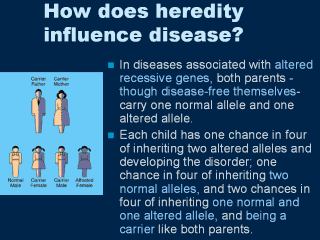|
|
|
|
front |1 |2 |3 |4 |5 |6 |7 |8 |9 |10 |11 |12 |13 |14 |15 |16 |17 |18 |19 |20 |21 |22 |23 |24 |25 |26 |27 |28 |29 |30 |31 |32 |33 |34 |35 |36 |37 |38 |39 |40 |Glossary |review |

|
Genes come in pairs, with one copy inherited from each parent. Many genes come
in a number of variant forms, known as alleles. A dominant allele prevails over
a normal allele. A recessive gene becomes apparent if its counterpart allele on
the other chromosome becomes inactivated or lost. For example, in cystic fibrosis (a disease that seriously impairs breathing and digestion), the gene that causes abnormal mucus production and disease is a recessive allele. A person who inherits one copy of the recessive allele does not develop disease because the normal allele predominates. However, such a person is a carrier who has a 50-50 chance of passing the altered recessive allele to each of his or her descendants. When both parents are carriers, the chance is one in four that a child will inherit two of the recessive alleles, one from each parent, and develop disease. (This chance remains one in four for each pregnancy.) Although most recessive mutations are rare, a few, including those for cystic fibrosis and sickle-cell anemia, are fairly common in specific ethnic groups. However, most diseases and traits don't follow simple patterns of inheritance; a variety of factors influence a gene's performance. To begin with, not all mutated alleles invariably lead to disease. Even with a dominant allele such as the BRCA1 breast cancer susceptibility gene, for instance, the risk of disease by age 65 is 80 percent, not 100 percent. This quality - an indication of the probability that a given gene mutation will produce disease - is referred to as penetrance. Not only can different mutations in the same gene produce a wide range of effects in different individuals, as is the case with cystic fibrosis, but also mutations in several different genes can lead to the identical outcome, as is the case with some forms of Alzheimer's disease. Some traits require simultaneous mutations in two or more genes. And a phenomenon known as imprinting can determine which of a pair of genes, the mother's allele or the father's, will be active or silenced. |